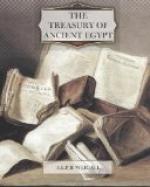When the mummy of Akhnaton was discovered and was proved to be that of a man of twenty-eight years of age, many persons doubted the identification on the grounds that the king was known to have been married at the time when he came to the throne, seventeen years before his death,[1] and it was freely stated that a marriage at the age of ten or eleven was impossible and out of the question. Thus it actually remained for the writer to point out that the fact of the king’s death occurring seventeen years after his marriage practically fixed his age at his decease at not much above twenty-eight years, so unlikely was it that his marriage would have been delayed beyond his eleventh year. Those who doubted the identification on such grounds were showing all too clearly that the manners and customs of the Egyptians of the nineteenth and twentieth centuries, so many of which have come down intact from olden times, were unknown to them.
[Footnote 1: Weigall: Life of Akhnaton, p. 56.]
Here we come to the root of the trouble. The Egyptologist who has not resided for some time in Egypt is inclined to allow his ideas regarding the ancient customs of the land to be influenced by his unconsciously-acquired knowledge of the habits of the west. Men do not marry before the age of eighteen or twenty in Europe: therefore they did not do so in Egypt. There are streams of water upon the mountains in Europe: therefore water may be hoisted upon the hillsides in Egypt. But is he blind that he sees not the great gulf fixed between the ways of the east and those of his accustomed west? It is of no value to science to record the life of Thutmosis III. with Napoleon as our model for it, nor to describe the daily life of the Pharaoh with the person of an English king before our mind’s eye. Our European experience will not give us material for the imagination to work upon in dealing with Egypt. The setting for our Pharaonic pictures must be derived from Egypt alone; and no Egyptologist’s work that is more than a simple compilation is of value unless the sunlight and the sandy glare of Egypt have burnt into his eyes, and have been reflected on to the pages under his pen.
The archaeologist must possess the historic imagination, but it must be confined to its proper channels. It is impossible to exert this imagination without, as a consequence, a figure rising up before the mind partially furnished with the details of a personality and fully endowed with the broad character of an individual. The first lesson, thus, which we must learn is that of allowing no incongruity to appear in our figures. A king whose name has survived to us upon some monument becomes at once such a reality that the legends concerning him are apt to be accepted as so much fact. Like John Donne once* says—
“Thou
art so true, that thoughts of thee suffice
To
make dreams truth, and fables histories.”
Transcriber’s note: Original text read “one”.




